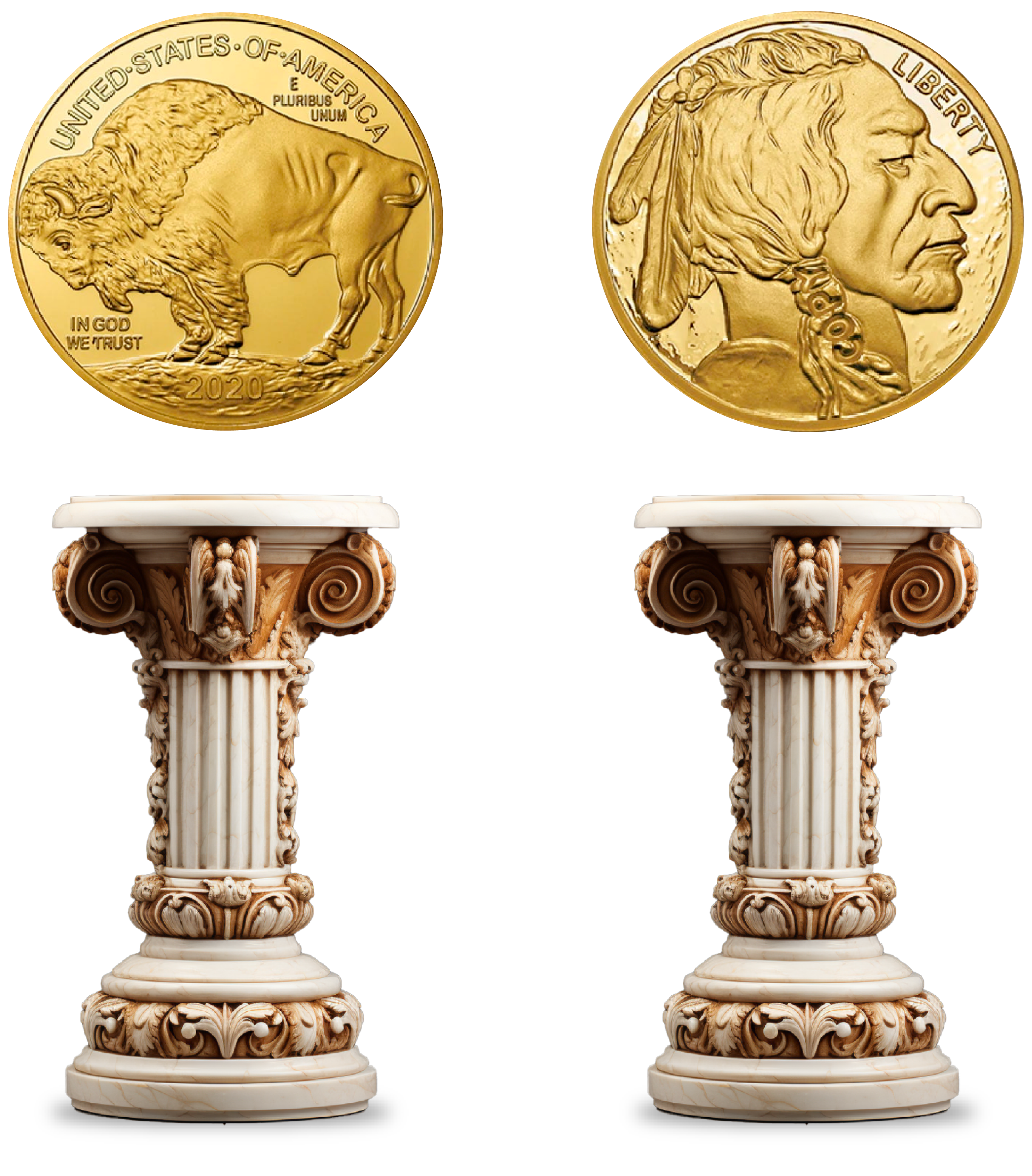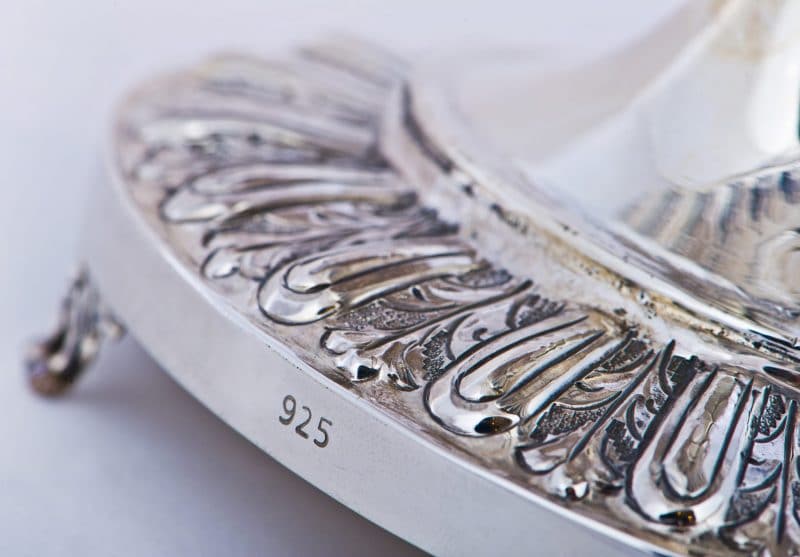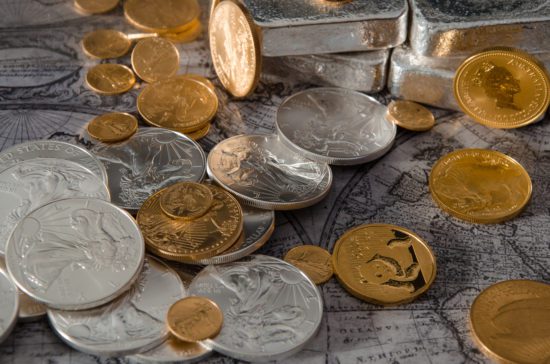
BUFFALO TRIBUTE PROOF COIN
THE HOTTEST COIN ON THE MARKET
What Is A 925 Sterling Silver?

The soft, white, lustrous transition metal known as silver has stood out as both a precious metal and metal of utility since antiquity. It has been formed into coins, jewelry, tableware (hence silverware), sculptures, and is even now included in solar panels and mirrors among other things. One of its most important roles in the modern world though is as a form of commodity money. In bullion form, it even has the currency code XAG.
It is one of only four precious metals to be given this designation along with palladium, platinum, and gold. These precious metals stand as a fiscal safeguard against the current financial system. Whether we think about it or not, all the money, in every global market, doesn’t have any real intrinsic value. This money is called “fiat currency” as its value is based solely on government issuance (the word “fiat” means “by decree”). Silver, on the other hand, whose value remains intrinsic, retains its monetary value no matter what the government says or does.
Silver In All Its Forms
When silver is pulled from the ground in places like Mexico, China, or Peru it is usually in the form of an ore like sulfide or copper. It is far from pure and, in its natural state, lacks much of the beauty and utility it is known for. The silver has to be extracted from its ore or mineral through a series of intensely hot and chemically complex processes before it can ever be used. In the final stages of extraction and purification, the silver reaches purity levels of 99.9% for commercial-grade applications. Purities greater than 99.999% are just as possible though.
That level of purity, however, is not what you would want for jewelry, bullion, or most other forms of silver. Why not? The purest forms of silver happen to be the softest, meaning that the purer it gets, the more fragile its physical form. A pure silver coin would scratch and bend fairly easily. The solution to this problem is to use a silver alloy which means the silver is mixed with other metals to lend it durability. While pure commercial grade silver sits at around 99.9% purity many applications use what is called sterling silver which has a purity of around 92.5%.
That 92.5% purity sterling silver is what we call 925 sterling silver or just 925 silver for short. The remaining 7.5% of the mixture is often copper, zinc, or a mixture of the two. This 925 standard is based on a numeric scale, or rating system, of 0-1000 based on the percentage of silver. Any silver that rates as 924 or below can’t be called sterling and is also less valuable because of this. Some countries, such as France, abide by even higher standards and their Sterling classification begins at 950 or 95% silver content.
How to Spot Sterling Silver
The quickest way to tell if something might be sterling silver is to look for the quality mark and the hallmark. These marks, or stamps, can be found on sterling silver jewelry mostly and they are discreetly included to indicate the authenticity of the piece. A quality mark will be something like “.925” or “925” or “S925” or even the word “Sterling” to indicate the composition of the piece. A hallmark is the jewelers or makers registered mark which is unique to them.
The presence of one or both of these marks indicates that a piece might be real sterling silver but, unfortunately, it doesn’t guarantee it. There are many high quality fakes out there of fine silver jewelry, coins, and bullion so to make sure you have the real thing you will have to go a step further. Weeding out the fakes has been refined to a science. You can easily pay a professional to check your silver for you but you can also conduct several tests from home.
Weeding Out the Fakes
Thanks to our understanding of chemistry, weeding out fakes has never been easier. Each element has unique characteristics that are very difficult, and sometimes impossible, to replicate. Like a detective, you can use a series of tests to determine if what you have is the real deal or just a piece of garbage. Before delving into the tests themselves it helps to understand some of the basic ways silver is applied and fakes are made.
Imagine you have a thick coin that you believe is made out of silver. If you’re correct the entire thing from the surface to core should be made out of sterling silver. In that case, it would be quite valuable. Some con artists are clever though, they make a core out of another worthless metal and just coat the coin in silver. Then they try to sell the coin as though it were made entirely of silver. The less clever con artists will coat a fake core with a fake silver imitation. Either way, this means that to weed out a fake you have to test the surface and core of a silver object to know if it is real.
There are plenty of tests for the outside of a piece of silver such as rubbing it with a white cloth. Silver likes to oxidize so when it is exposed to air it turns black. If you rub pure or sterling silver with a white cloth you will get a black mark on the cloth. This will at least tell you if something is plated in silver. There are other tests like this too.
You can place a drop of bleach on a silver suspect and if it turns black you have silver. This test can impact the value of some silver pieces though so be careful. Similarly, you can use testing kits with solutions of nitric acid and muriatic acid to verify the silver. Tests like these all fall short of determining if the whole piece is silver though. To do that you need better tests to determine if something is silver through and through.

Silver Through and Through
Since 925 sterling silver is made up of 92.5 percent silver, a sterling coin or piece of jewelry will heavily exhibit the unique characteristics of silver. For one, silver, like gold, is not magnetic. If a silver coin sticks to a magnet it is either silver plated or it is a fake entirely. However, just because a coin doesn’t stick to a magnet doesn’t mean you are out of the woods yet. Fake cores can be made out of other nonmagnetic metals.
One of the quickest ways to determine if the coin is silver through and through is to employ the ping test. Simply place your suspected silver coin on the tip of your finger and strike it with another piece of metal. It should make a characteristic ping sound that you can hear in this video demonstrating the test. This works because silver resonates at a certain frequency of about 6145 Hz. It is very difficult (i.e. you would probably need a Ph.D.) to replicate that sound with an alloy so if there was a fake core in the coin you would get a different sound.
Still, being a good detective you can’t rely on just one test to determine the authenticity of your silver. The text test you can do is called the specific gravity test. Specific gravity tests the density of something which is unique to the elements it contains. The specific gravity of water, for example, is 1 while the specific gravity of silver is 10.49. To test this you just need a good digital scale and small cup of water.
Specific gravity = weight of silver/weight of silver submerged in water
To figure this out you just have to weigh your coin dry and then set up an apparatus to weigh it while submerged. Use a cup of water full enough to fully submerge the silver and then reset the scale with it on. Next tie some string around the coin and setup an apparatus to hold the coin above the bottom of the cup. Weigh the coin while submerged and there you have it. You can calculate the specific gravity.
Some counterfeiters can replicate the specific gravity of silver but when combined with the ping test and visually checking the coin you should be able to identify any fakes. Professional testers take things a step further and use some high tech equipment to check for fakes. One $10,000 plus piece of kit that is employed is called an XRF Analyzer which uses X-ray fluorescence to tell you exactly what something is made out of. There is also an ultrasonic thickness gauge which uses sound to determine the composition of things.
Caring for Silver
Most silver care recommendations are geared towards those individuals with actual silverware like forks and knives. The basic principles still apply to any jewelry, coins, or bullion you might have. Sterling silver likes to oxidize meaning that if it sits untouched and exposed to oxygen long enough it will corrode and tarnish. Tarnishing will take the beautiful white luster of your piece and slowly turn it into a dark brown or black.
As a general rule of thumb, the more valuable a piece of silver is the more you should take it to a professional cleaner and restorer. With some jewelry and antiques, it is possible to over clean and even damage the piece. If that is less of a concern then you can probably tackle the cleaning yourself. For starters, it is always a good idea to store valuable silver in low oxidizing sealed containers or bags. If you must take it out to handle it or use it you should immediately wipe it down after with a soft lint-free cloth.
If tarnish has badly built upon the piece you can start cleaning it by swabbing the surface with methylated or white spirit to remove grease and dirt. With remaining tarnish try gently rubbing a silver cloth over the surface. These clothes have small abrasive particles embedded in them. After using the silver cloth rub the piece down with an alcohol moistened swab to remove the residue. This should remove almost all tarnish if not all of it. If any stubborn tarnish remains you can try applying a silver foam. There will be instructions with any foam you get and you should follow those.
Why Invest in Silver?
As we have previously addressed, the currencies of most global financial systems are fiat currencies which means they only have value because the government says they do and the people agree. The value of these volatile fiat currencies is subject to inflation, political upheaval, the whims of central banks, and all the other factors on the long and growing list of financial factors that govern a market. Actually, fiat currencies around the world immediately began losing value against the USD in the wake of the COVID-19 pandemic. The United States dollar isn’t immune either though.
Silver’s role is to help counterbalance this volatility. Like other precious metals, there is an inverse relationship between the U.S. dollar and silver. Silver also holds its value longer than the dollar, making it an effective hedge against inflation. Silver doesn’t directly correlate with other asset classes like stocks or real estate since it is influenced by other factors. This makes silver a great diversification tool.
Silver, along with other precious metals, can be a vehicle to safeguard investments. A brief study of the history of silver prices shows how the value of silver excels in the wake of financial disasters like the recession in 2008. From 2007 to 2011 silver basically doubled in value while other forms of investment struggled to regain traction. This is the value of precious metals. When the fiat system is collapsing, assets like gold and silver tend to rally.
But silver’s most significant value as an asset for investment is its rarity and tangibility. We can print more money but we can’t print more silver. This limited and increasingly rare precious metal has tremendous practical value in numerous electronics applications and even some healthcare applications. Interestingly enough, silver is 17.5 times more abundant in the Earth’s crust than gold. Still, because of it’s rampant use in electronics, large swaths of it are being mined, used, and then sent to landfills to be buried. What remains in the Earth is quickly being lost to the trash heap.
Silver is an investment tool that can provide necessary diversification in a chaotic economic system that relies on fiat currencies. The precious metal can even safeguard your wealth in times of extreme economic turmoil as in the case of a recessionary environment. The perceived and intrinsic value of silver has stood the test of time. It is even known as one of the seven metals of antiquity dating back to 4000 BC. In short, silver is here to stay.

How Does Silver Compare to Gold?
Silver and gold are actually two monetary assets that you should purchase simultaneously. Why? Each plays a unique role in securing wealth, guarding against inflation, and stabilizing a portfolio. Between the two, gold has a much larger market value than silver, making silver prices more volatile. Silver will have higher highs and lower lows than gold. As an investor, you just have to ride these waves as they happen. Keep in mind, it is all relative. Historically, silver has fallen more than gold in bear markets and risen more than gold in bull markets.
Silver is also cheaper than gold. This is great for an investor because you can buy more of it. Physical silver has all the same investment benefits as gold but at a cheaper price point. A savvy investor holds both gold and silver. You can make smaller investment plays in silver while holding larger sums in gold. These are the two precious metals that should be a part of any wealth management strategy.
One last difference that is intriguing is the fact that global stockpiles of gold are rising while the stockpiles of silver are falling. Paired with the understanding that silver is a critical component in the electronics industry and demand there isn’t slowing it seems likely that owning physical silver could become extremely profitable under certain conditions. A government buyback of silver for use in the industry could make every troy ounce worth more than its weight in gold.
Final Verdict:
Silver is a beautiful precious metal that has remained relevant and valuable for thousands of years. We now refine it into 925 sterling for jewelry and even higher purities for other applications. It is a metal that graces everything from forks to solar panels. It is also a critical component of any wealth management or investment strategy. Holding physical silver is the best way to hedge against fiat currencies and benefit from the stability that precious metals provide.

